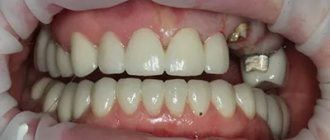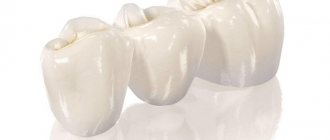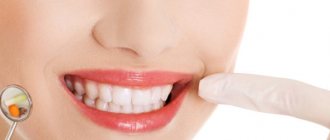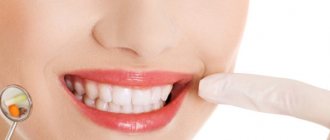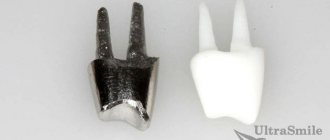Not a single person is immune from a situation with a chipped tooth: even strict adherence to the norms and rules of hygiene, a healthy lifestyle does not exclude such risks, because one of the causes of chips is injuries.
The good news is that in most cases, you can restore your tooth to its original shape and function, and your smile to its beauty quickly, painlessly and inexpensively. Modern dentistry has many recovery tools; the main thing is to try to see a doctor as soon as possible and not ignore the problem.
The difference between chips and other diseases
Many patients confuse chips with similar injuries or diseases of the oral cavity. However, despite the similarities, it is important to distinguish certain conditions into separate problems that require a completely different approach to treatment. The most common similar conditions are the following:
- Tooth fracture. It exposes the coronal and sometimes the root part of the pulp, which leads to its death; it is almost impossible to save a tooth with a root fracture - it must be removed.
- Wedge-shaped defect - looks like a chip in the cervical part of the tooth; it is a non-carious lesion. In especially severe cases, such an enamel defect can cause the entire crown to chip off.
- Chip accompanied by dislocation. It usually appears as a result of injuries and complicates the treatment process, since the doctor’s task is not only to restore the shape of the crown, but also to treat the dislocation.
That is why, in cases where part of a tooth has broken off, an accurate diagnosis is carried out. Mechanical injury requires careful assessment of the consequences before starting treatment. The dentist may prescribe x-rays and other examination methods and methods to exclude serious consequences of damage.
Ask a Question
Manufacturing
The process of making inserts is not as simple as it might seem at first glance. To begin with, the Azbuka dentist must prepare the remains of living tooth tissue for taking an impression. If necessary, the canals are sharpened until they are parallel, and the inside of the tooth is treated with Vaseline. Special plastic for modeling is diluted to a liquid state, poured into a syringe and carefully inserted into the channels and onto the internal walls, then ashless pins are inserted into the channels.
To create a model of an inlay of the required size, the tooth is limited to a special matrix, along the height of which quick-drying plastic is added. When the plastic hardens, the tab is carefully removed from the tooth. The doctor’s main task at this stage is not to damage the model, since plastic is a very capricious material.
The doctor should check the finished model for defects and pores and eliminate them if possible. If elimination is not possible, it is better to redo the model again. After removing the inlay, the tooth canals should be disinfected and a temporary filling should be placed, and the finished model should be handed over to a dental technician to make a core crown. The manufacture of core inlays for 2-3-root teeth with parallel canals is not very different from single-canal ones, but if the canals are not parallel, the manufacture of a cast or collapsible structure depends on the position of the tooth.
Reasons for chipping
The mechanism for the development of chipping is a mechanical effect on the tooth enamel. But one person can crack nuts with his teeth, while another may have enamel chipped off as a result of eating seeds. This means that weakened enamel is a major risk factor for chipping. There are several reasons for its weakening:
- Frequent, repeated injuries, for example, in connection with professional or sports activities, traumatic hobbies.
- The habit of chewing pens or pencils, opening bottles with teeth, etc.
- Demineralization of enamel - areas with a reduced amount of minerals, which may be associated with endocrine diseases, poor nutrition, age-related changes and more.
- Caries, which is not noticeable during a normal visual examination - cervical or interdental, is not detected immediately, but can quietly destroy the tooth and make it more fragile.
- Malocclusions, in particular crossbite: due to the defect, the chewing load is distributed incorrectly. As a result, pressure increases on one group of teeth, which weakens the enamel.
- A chipped tooth may be associated with a filling defect, secondary caries, etc. In addition, removal of the pulp during endodontic treatment can lead to a weakening of the tooth enamel structure.
- Fixation of an orthodontic structure on weakened tooth tissues.
- Violations of hygiene rules are an indirect cause, but the accumulation of dental plaque and the formation of hard dental deposits can become a factor in greater vulnerability of the enamel.
- Consumption of hard, viscous foods.
- Temperature difference - eating hot and cold food and drinks at the same time or alternately. This causes small, invisible cracks in the enamel and weakens its structure.
- Bruxism, diseases of the temporomandibular joint, dystonia of the masticatory muscles, leading to jaw closure, voluntary and involuntary grinding.
- Smoking. Changes in the acidity of the oral cavity, saliva composition associated with systemic diseases, dietary habits and other factors
We found that a tooth is more likely to chip if the enamel is weakened or its structure is changed. However, chips are different, each case requires a special approach and the selection of individual restoration measures.
How to restore a tooth with different degrees of damage?
Repairing a chipped front tooth
If a small part of your tooth has broken off, which is more of an aesthetic problem, in this case it is possible to build up the crown using filling material. To do this, you will need to apply anesthesia, apply a rubber dam and build up the broken corner.
Restoring half a tooth
To the question whether it is possible to restore half a tooth, the answer lies on the surface - it is possible. For this, an artificial crown is used; in some cases, the use of pins is also acceptable. There are specialists who may immediately refuse to restore the remaining half of the tooth. Do not despair, perhaps you should find a more qualified specialist, since in the 21st century it is possible to restore a tooth at almost any stage of damage.
Restoring a tooth from 1 wall
If you have one tooth wall left, is it possible to restore it? It’s a simple question. With the help of an artificial crown, you can restore most of the tooth and protect it from further destruction. The use of pins is advisable only if the incisors or fangs are damaged, since the chewing teeth bear a large load and the pins will not be able to cope with it. In addition, a crown is more reliable, especially when less than half of your tooth remains.
Restoring a broken tooth at the root
If a tooth is broken at the root, whether it can be restored depends on the length of the remaining root. It should be enough to install implants. The wall thickness of the remaining root of the broken tooth should be at least 1 mm. In this case, the remaining tooth is first strengthened using a pin or stump tab, and then the question arises of restoring its aesthetic appearance. Once the shape of the tooth is restored, the dentist begins the crown part. The enamel color is selected to best match the color of your teeth, various composite materials are used to create the outer layer, and then the implant is ground for maximum naturalness.
Restoring a completely damaged tooth
Whether it is possible to restore a completely destroyed tooth is an open question at the moment. It all depends on whether at least some part of the root remains, and if it remains, then whether it makes sense to restore it. In this case, the best solution may be not extension, but installation of a prosthesis. Before deciding whether a tooth can be restored or whether it is better to install an artificial one in its place, a thorough examination of the oral cavity and consultation with a highly qualified dentist is necessary.
So, restoring the appearance of a tooth is a complex process, but, thank God, it is quite real. If you have a chipped or broken tooth, do not wait, but seek help immediately to prevent further tooth decay. If all that’s left of the tooth is the root, especially don’t hesitate, high-quality pins or an artificial crown will save your situation, the most important thing is choosing a competent specialist, then your teeth will serve you for many years and decades.
Types of chips
There is a conditional classification of chips:
- Enamel chip - in this case, the patient will most likely report that a piece of the tooth has broken off. This injury is not accompanied by pain. Sometimes the defect is not even noticeable and invisible to the eye. In certain cases, trauma can lead to increased sensitivity of the causative tooth to cold, hot, sour and sweet foods, and cool air.
- Dentin chip: in this case, the patient observes that a rather large piece of the tooth has broken off. The injury is visible to the naked eye, and unpleasant or painful sensations appear. If the dentin chip is not repaired quickly, the tooth will quickly continue to deteriorate.
- A deep chip that leads to exposure of the pulp as a result of a fracture of the tooth crown. Opening the pulp chamber can lead to bleeding, always accompanied by acute pain. However, taking analgesics rarely brings the desired result. In this case, it may not be possible to save the pulp even if you consult a doctor early, but it is important to visit the dentist as soon as possible in order to save the tooth and get rid of pain.
Symptoms of chipping
If the chip is small, no symptoms may appear. Sometimes a person begins to guess about a chip because of the appearance of roughness of the tooth or its sharp edge. If we are talking about a tooth in which the pulp was previously removed, then even a large chip will not lead to pain.
In the event that part of the enamel next to the installed filling was chipped, this can affect its service life and even cause immediate loss or destruction.
Despite the fact that a small chip sometimes only causes aesthetic inconvenience, it is better to restore the previous shape of the tooth crown as soon as possible. Otherwise, the tooth may continue to deteriorate, and the rough enamel surface is an ideal environment for the proliferation of cariogenic bacteria and plaque accumulation.
Causes of chipped teeth
Several many:
- Weakening of dental tissue due to large consumption of sweets, juices, carbonated drinks and other foods that contain large amounts of sugar and acid;
- Malocclusion;
- Lack of calcium in the body;
- Reduced acidity in the oral cavity;
- Caries;
- Other diseases of the oral cavity;
- General weakening of the immune system;
- Hormonal disorders;
- Smoking;
- Diseases of internal organs.
These reasons, by the way, can also cause loosening of teeth and the development of all kinds of chronic diseases.
What to do if a tooth chips off
If a tooth chips, there is no need to panic. It is important to take no action until you can see a doctor. The most common mistakes are the following:
- attempts to “grind” the damaged area of enamel: this can lead to serious problems;
- an attempt to check the mobility of the tooth: it is not worth acting on it mechanically in any case;
- rinsing the mouth with antiseptics not intended for this purpose: as a result, burns of the mucous membranes and other complications.
How to help yourself in the first hours
You can rinse your mouth using regular or antiseptic rinses or chamomile decoction at room temperature. It is better to brush your teeth more carefully using a brush with soft bristles, and if you don’t have one, avoiding an injured tooth.
If there is a fracture of the crown and bleeding, it can only be stopped with a piece of sterile bandage or sterile cotton wool; there is no need to introduce material into the tooth! If acute pain is observed, you can take an analgesic; it is better to choose one that you have already taken before and the reaction to which is known.
It is important to understand that such measures do not eliminate the need to see a dentist as soon as possible. This will help preserve the tooth and prevent complications, quickly restore its normal shape.
Possible complications
- severe pain, swelling;
- root fracture;
- restoration chips;
- the occurrence of a local allergic reaction to the material from which the rod is made;
- development of the inflammatory process (stomatitis, periodontitis);
- cyst development;
- fistula formation;
- mechanical damage to the walls of the tooth, which can lead to perforation of the root canals;
- splinters from dental instruments getting into the root canal.
It is important to know. The most dangerous complication is rejection of the installed supporting element by the body. In this case, it must be completely removed from the oral cavity.
Methods for restoring a tooth after a chip
In cases where a piece of a tooth has broken off, the doctor will conduct a visual examination. X-rays and other additional examinations may be required to select a treatment method.
For minor chips, it may be enough to saturate the enamel with minerals and make the surface of the damaged area smooth. This is especially true in cases where slight grinding of tissues will not lead to an aesthetic defect, for example, asymmetry.
With an average chip, it is difficult to do without the use of artificial materials. You will need to use a filling material, an artistic restoration method, or other tools to restore the shape of the tooth.
When the pulp is opened, it will most likely be removed, the root canals will be filled, and the crown will be restored with a filling or prosthesis. Sometimes it is not possible to restore a tooth. Then its removal and subsequent installation of an implant is required.
The method of restoration is determined by several factors: the degree of destruction, the diagnostic result and identification of the causes of the chip, the general condition of the oral cavity, the wishes of the patient, etc. Let us consider the methods of restoring teeth after various chips in more detail.
Root crack diagnosis
Only a doctor can diagnose an injury. First, the specialist makes a preliminary diagnosis based on the patient’s symptoms and complaints. More detailed research is required to clarify.
- Instrumental examination.
By tapping the tooth, the doctor determines whether there are irregularities, fractures or bleeding in the root of the tooth. - X-ray.
The image clearly shows the tooth root crack, its location and the severity of the injury. - Electrical exposure
helps determine the condition of the pulp.
Artistic restoration
This method is also called extension. This method is widely used for noticeable chips and moderate chips. Restoration consists of layer-by-layer application of a special composite material. Each layer is illuminated with a special lamp. The doctor may use various tools to give the tooth a natural shape. This is a direct artistic restoration. It involves restoration directly in the patient’s mouth.
Indirect restoration involves the installation of restorative structures, previously made according to an individual impression in a dental laboratory. This group of methods includes ceramic veneers, inlays - fillings, pre-made in the laboratory according to exact parameters.
Both restoration methods can restore the shape and function of a chipped tooth effectively and aesthetically. Materials are selected to match the tone of your own enamel. Indirect restorations are more reliable and aesthetically pleasing.
Sealing
This method is indicated for chips that appear as a result of carious tooth decay, as well as for major damage to the tooth crown. In this case, radiographic examinations are often required. If the crown is significantly damaged, filling may be ineffective - the filling simply cannot last long. In this case, the doctor will offer alternative options.
If the pulp is damaged, filling alone may not be enough. First, the pulp is removed, treated and the root canals are filled. Then the crown of the tooth is restored using filling material or another method.
Molded tab
In modern dental practice, cast stump pins are used much more often than collapsible ones, since their manufacture and installation are much simpler than the latter. Such an insert usually consists of a main platform that restores a defective tooth, and fixing pins that ensure reliable fastening of the entire structure in the tooth canals.
A cast stump inlay implies monolithically interconnected parts, the separation of which during installation or further use is impossible. Most often, such structures are used to restore single-rooted teeth, as well as double-rooted teeth with non-parallel canals. Using a solid inlay in teeth with three and four canals is extremely problematic.
Installation of an artificial crown
A fracture of the crown of a tooth or a chip exposing the pulp may make it impossible to restore the crown portion using conventional composite materials. In this case, endodontic treatment is carried out - pulp removal, root canal filling, as well as installation of a pin and an artificial crown. It can be made of different materials: metal, metal ceramics, ceramics, zirconium dioxide. The choice of material is determined by the desires for strength and aesthetics.
In extreme cases, it is not advisable to restore a tooth even with a crown. So, if a piece of a wisdom tooth breaks off, restoring it in most cases is impractical. It does not bear a chewing load, so the dentist will suggest removing the figure eight. The same applies to cases of root fracture.
Collapsible stump tab
Since it is impossible to insert a cast inlay into a root with three or four channels without damaging the tooth tissue, there is a need to manufacture a collapsible structure. After receiving an impression of the tooth, an ABC dental specialist in the manufacture of inserts must determine which pins freely enter and exit the canals, and which ones will have to be made removable due to their location at an angle to the main mass of the inlay or the central pins.
When properly manufactured and installed, a collapsible stump tab is not much different from a cast one. It fits perfectly to the shape of the tooth, leaving no gaps or gaps due to the ease of insertion into the canals. Once installed, it is simply impossible to remove such an insert from the tooth, since all the pins are located in the root at different angles, which is why it will have a lifetime warranty.
Complications of chips
It is necessary to restore the shape of a tooth in case of chips of any scale to avoid complications. Most patients strive to get to the dentist as quickly as possible due to the unaesthetic nature of the problem, especially if part of the front tooth has chipped off. But there are other consequences that affect oral health. These include:
- tooth mobility, tooth loss;
- malocclusion;
- hyperesthesia of a damaged tooth - increased sensitivity;
- increased risk of developing caries and its complications in the form of pulpitis, periodontitis;
- injury to the soft tissues of the gums, cheeks, and tongue due to the sharp edges of the chip.
Therefore, it is important to visit a doctor and choose the appropriate restoration method.
What is a stump tab?
A stump inlay is an indispensable item when restoring severely damaged teeth. There are cases when a patient comes to the dentist with a tooth broken at the root in such a state that it is easier to remove it and install an implant, but the patient’s will is the law, and if he wants to restore a tooth with almost complete absence of walls, the doctor can help in this difficult matter. stump pin inserts .
For quite a long time, before the advent of pins manufactured on an industrial scale, the treatment of this type of destruction was carried out using an individual approach.
A stump inlay is a structure specially made from an impression and fixed with a cementing composition into the pre-processed holes of the tooth being restored, onto which the dentist subsequently builds up the walls and crown.
Unlike pins, stump inlays are not installed on damaged teeth in one visit, and for many dentists, and even for patients themselves, this option is very inconvenient. And, nevertheless, their use guarantees that such a tooth will definitely never break or be susceptible to destruction, i.e. will last with the person for the rest of his life, and will not be limited to the warranty period, which is typical for ordinary pins.
The fact is that, unlike a pin, the stump insert redistributes the load on the entire tooth evenly , since it has support over the entire surface and is fixed in each root canal. Fastening with a cementitious composition ensures a completely tight fit to the remains of the tooth, which prevents the formation of microcracks into which food debris or liquid could get in, causing the development of caries.
Of course, the use of modern factory pins speeds up and reduces the cost of restoring a damaged tooth, which is sometimes beneficial for both the doctor and the patient, but at the same time the quality of the work suffers, which will not happen if your choice is a stump crown. Let's look at the main differences between pins and inlays.
Prevention measures
It is difficult to prevent chipped teeth, but you can strengthen the enamel and increase its resistance to mechanical stress. To do this, you should adhere to the following recommendations:
- adhere to the rules of oral hygiene;
- eat well;
- treat caries promptly;
- Visit your dentist twice a year for professional cleanings and examinations;
- give up bad habits, cracking nuts;
- undergo orthodontic treatment if necessary;
- keep systemic and endocrine diseases under control;
- minimize the risk of injury.
For an in-person consultation and choosing a method of tooth restoration, you can contact one of the STOMA clinics. The professionalism of our dentists and a wide range of modern high-quality materials allows us to offer patients high-quality treatment and effective restoration. You can make an appointment either by phone or through a special form on the website.
